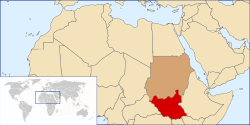Southern Sudan Autonomous Region (1972–83)
| Southern Sudan Autonomous Region | |||||
| Autonomous region of Sudan | |||||
| |||||
 Sudan (brown) in central / northern Africa. | |||||
| Capital | Juba | ||||
| History | |||||
| • | Addis Ababa Agreement | February 28, 1972 | |||
| • | Region abolished | June 5, 1983 | |||
| Area | |||||
| • | 1983 | 619,745 km2 (239,285 sq mi) | |||
| Population | |||||
| • | 1983 | 5,466,700 | |||
| Density | 8.8 /km2 (22.8 /sq mi) | ||||
The Southern Sudan Autonomous Region was an autonomous region that existed in Southern Sudan between 1972 and 1983.[1] It was established on 28 February 1972 by the Addis Ababa Agreement which ended the First Sudanese Civil War.[2] The region was abolished on 5 June 1983 by the administration of Sudanese President Gaafar Nimeiry.[3] Revocation of southern autonomy was a cause of the Second Sudanese Civil War which would continue until January 2005, when southern autonomy was restored.
Government and politics
Southern Sudan was governed by a High Executive Council which was led by a President of the High Executive Council. Abel Alier was the first President, holding that post between 1972 and 1978.
Legislative authority was vested in a People's Regional Assembly.
The autonomous region consisted of the three provinces of Equatoria, Bahr al-Ghazal, and Greater Upper Nile. Juba was the regional capital.
Presidents of the High Executive Council
| Tenure | Incumbent | Party |
|---|---|---|
| 6 April 1972 – February 1978 | Abel Alier | Southern Front |
| February 1978 – 12 July 1979 | Joseph Lagu | Sudan African National Union |
| 12 July 1979 – 30 May 1980 | Peter Gatkuoth | |
| 30 May 1980 – 5 October 1981 | Abel Alier | Southern Front |
| 5 October 1981 – 23 June 1982 | Gismalla Abdalla Rassas | Southern Sudan Liberation Movement |
| 23 June 1982 – 5 June 1983 | Joseph James Tombura | Sudan African National Union |
Post-abolition
The Southern Sudan Autonomous Region was abolished in 1983. Between 1987 and 1989 a Council for the South existed in Southern Sudan. Following the signing of the Khartoum Peace Agreement of 1997, a Southern Sudan Coordination Council was established initially led by Riek Machar who was also appointed Assistant to the President of the Republic. This body was abolished in 2005 when the autonomous Government of Southern Sudan was established.[4]
See also
- South Sudan
- Comprehensive Peace Agreement
- Government of Southern Sudan (2005–2011), the autonomous government that existed between 2005 and independence in 2011
- Southern Sudanese independence referendum, 2011
References
- ↑ Ben Cahoon. "The Sudan". Worldstatesmen.org. Retrieved 2016-02-29.
- ↑ "武蔵村山市新築図録 | 武蔵村山市には新築がいっぱい♪" (PDF). Splamilitary.net. Retrieved 2016-02-29.
- ↑ https://web.archive.org/web/20110716052232/http://www.pachodo.org/201010061749/Pachodo.org-English-Articles/history-of-southern-sudan-hoss.html. Archived from the original on July 16, 2011. Retrieved January 11, 2011. Missing or empty
|title=(help) - ↑ Ben Cahoon. "Southern Sudan". Worldstatesmen.org. Retrieved 2016-02-29.